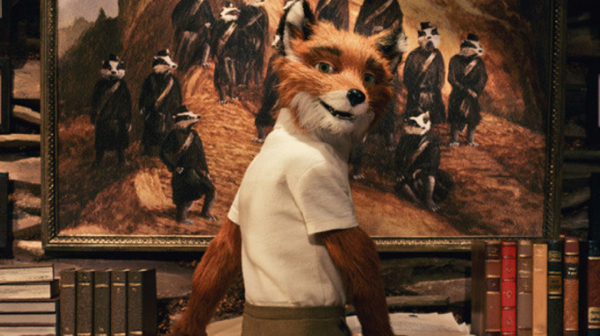Movie review by Greg Carlson
Like each one of Wes Anderson’s features, “Fantastic Mr. Fox” comfortably floats in the space between the familiar and the not quite real, the grown-up and the childlike. Loosely adapted from the 1970 book by Roald Dahl, the movie concerns the survival of the title character and his family and friends, but the great joy of the film lies mostly in the gorgeous execution of its handmade, meticulously crafted animation. The miniature world inhabited by Mr. Fox is as artfully arranged as any of Anderson’s previous sets and equally as complete. Repeated viewings will reveal a nearly endless supply of dazzling details, from the tiny oil painting of posing badgers to the “unaccompanied minor” tag pinned to a young traveler’s clothing.
The plot, a straightforward series of challenges between Mr. Fox (George Clooney) and a trio of awful farmers who aim to put an end to his thievery, alternates between the action chase and the kinds of scenes Anderson lovers expect: perfectly observed moments of pain and joy, where characters question their motives and jealousies aloud. The style, like Shakespearean soliloquies with arid, arch, contemporary brevity replacing iambic pentameter, works like a charm in the mouths of the woodland cast. One can almost hear Hamlet’s contemplative yearning when Clooney’s middle-aged larcenist muses on his nature, “Why a fox?”
Anderson’s drive to shoot the movie using stop-motion pays off tremendous dividends. Despite joining a long tradition marked by the indelible imprint of past masters, “Fantastic Mr. Fox” is wholly its own. In other words, the technique may not be original, but the end result is sui generis: it’s not Willis O’Brien on “King Kong,” not Tadahito Mochinaga’s work for Rankin/Bass, not Harryhausen or Starewicz, neither Nick Park nor Henry Selick. The fastidious Anderson outdoes himself with the level of minutiae in the production design, working with Nelson Lowry to achieve spectacular autumnal landscapes and richly textured interiors.
Like the conversations held between characters in his other ensembles, the exchanges in “Fantastic Mr. Fox” run the gamut from shocking self-disclosure to sly prevarication. The director has always had a gift for externalizing self-doubt – particularly among the intellectually gifted – and Jason Schwartzman’s Ash is the very embodiment of wounded inadequacy. Ash’s competition with talented cousin Kristofferson (Eric Chase Anderson) recalls similar dysfunctional rivalries in “The Darjeeling Limited” and “The Royal Tenenbaums,” but the younger age of these characters infuses their relationship with real tenderness. A late night scene in Ash’s bedroom in which the kits address sleeping arrangements is among the movie’s most sublime treats.
Because “Fantastic Mr. Fox” was directed by Wes Anderson, the film will be scrutinized and analyzed by all sorts of bloggers and academics who will comb through the text for traces of submerged meaning. Charges of racism, for example, have already been leveled at the movie, although Laura Bans appears to be on less solid ground than Jonah Weiner, who wrote about Anderson’s “unbearable whiteness” for “Slate” in 2007. A more credible complaint is the movie’s dearth of important female characters. Felicity Fox (Meryl Streep), like Etheline Tenenbaum, is the glue that keeps her family from disarray, a wise maternal presence whose calm contrasts with her husband’s wilder nature. Most of the speaking roles, however, belong to males. It’s a minor complaint, but it would be nice to see a more equitable distribution in the future.
